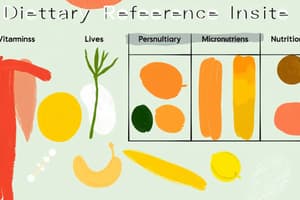Podcast
Questions and Answers
What is the primary purpose of the Dietary Reference Intakes (DRIs)?
What is the primary purpose of the Dietary Reference Intakes (DRIs)?
- To establish legal limits for food additives.
- To recommend specific meal plans for individuals with dietary restrictions.
- To establish a single ideal intake for each nutrient.
- To assess and plan dietary intake for healthy individuals and groups. (correct)
What does the Estimated Average Requirement (EAR) represent?
What does the Estimated Average Requirement (EAR) represent?
- The recommended daily intake based on a 2,000 calorie diet.
- The maximum amount of a nutrient that is safe for most individuals.
- The daily intake level sufficient for most of the population.
- The average daily intake level to meet the needs of half of healthy individuals. (correct)
If an individual consistently consumes the EAR for a particular nutrient, what is the potential outcome?
If an individual consistently consumes the EAR for a particular nutrient, what is the potential outcome?
- They have a high probability of experiencing toxicity.
- Individuals requiring more than the average amount may become deficient over time. (correct)
- They are guaranteed to avoid deficiency.
- They will always meet the ideal intake for all nutrients.
How is the Recommended Dietary Allowance (RDA) related to the Estimated Average Requirement (EAR)?
How is the Recommended Dietary Allowance (RDA) related to the Estimated Average Requirement (EAR)?
Which of these values is calculated differently from the RDA due to risk of weight gain?
Which of these values is calculated differently from the RDA due to risk of weight gain?
When is an Adequate Intake (AI) established?
When is an Adequate Intake (AI) established?
What is the purpose of the Tolerable Upper Intake Level (UL)?
What is the purpose of the Tolerable Upper Intake Level (UL)?
What does the Daily Value (DV) primarily represent?
What does the Daily Value (DV) primarily represent?
Which value is NOT intended for assessing an individual's adequacy of intake?
Which value is NOT intended for assessing an individual's adequacy of intake?
Which of the following is MOST likely to be similar or close to the Recommended Daily Allowance?
Which of the following is MOST likely to be similar or close to the Recommended Daily Allowance?
Flashcards
Dietary Reference Intake (DRI)
Dietary Reference Intake (DRI)
A set of nutrient reference values for healthy people in the United States and Canada. Used to assess and plan dietary intake for individuals and groups.
Estimated Average Requirement (EAR)
Estimated Average Requirement (EAR)
The average daily nutrient intake estimated to meet the needs of half of healthy individuals in a specific life stage and gender group.
Recommended Dietary Allowance (RDA)
Recommended Dietary Allowance (RDA)
The recommended daily intake level sufficient to meet the needs of nearly all (97-98%) healthy individuals in a particular life stage and gender group.
Estimated Energy Requirement (EER)
Estimated Energy Requirement (EER)
Signup and view all the flashcards
Adequate Intake (AI)
Adequate Intake (AI)
Signup and view all the flashcards
Tolerable Upper Intake Level (UL)
Tolerable Upper Intake Level (UL)
Signup and view all the flashcards
Daily Value (DV)
Daily Value (DV)
Signup and view all the flashcards
Who sets the DRI values?
Who sets the DRI values?
Signup and view all the flashcards
EAR and Deficiency
EAR and Deficiency
Signup and view all the flashcards
UL and Toxicity
UL and Toxicity
Signup and view all the flashcards
Study Notes
Dietary Reference Intake (DRI) Values
- DRIs are a set of nutrient reference values for healthy people in the United States and Canada.
- DRIs are used to assess and plan dietary intake for individuals and groups.
- DRIs are established by the Food and Nutrition Board of the National Academies of Sciences, Engineering, and Medicine.
Estimated Average Requirement (EAR)
- EAR is the average daily nutrient intake level estimated to meet the requirement of half of healthy individuals in a particular life stage and gender group.
- It is the middle of the bell-shaped curve representing the nutrient requirement distribution in the population.
- Consuming the EAR for a long time will not lead to deficiency in individuals requiring less than the average amount.
- However, individuals requiring more than the average amount will become deficient over time.
Recommended Dietary Allowance (RDA)
- RDA is the recommended daily intake level sufficient to meet the needs of nearly all (97-98%) healthy individuals in a particular life stage and gender group.
- RDA is set two standard deviations above the EAR.
- It ensures adequate nutrient intake for the majority of the population.
- RDAs are set for essential nutrients like vitamins and minerals.
Estimated Energy Requirement (EER)
- EER is an individual's estimated calorie needs based on age, gender, height, weight, and physical activity.
- It is not calculated using the same method as RDA due to the risk of weight gain with excess calorie intake.
Adequate Intake (AI)
- AI is established for nutrients where there is insufficient scientific data to set an RDA.
- AI is determined by examining the average intake of healthy individuals who appear to be meeting their nutrient needs.
Tolerable Upper Intake Level (UL)
- UL is the maximum daily intake level of a nutrient that is unlikely to pose health risks for most individuals.
- Exceeding the UL on a regular basis can lead to toxicity.
- The UL is relevant for nutrients where excessive intake may lead to adverse effects.
Daily Value (DV)
- DV is a reference value used for food labeling.
- It applies to people from ages 4 and up and is based on a 2,000-calorie diet.
- DV values are often similar to or close to the RDA.
Studying That Suits You
Use AI to generate personalized quizzes and flashcards to suit your learning preferences.






